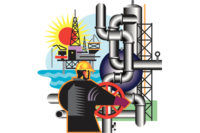Respiratory risks are most prevalent in the construction, shipyard employment, marine terminals and longshoring industries due to workers’ increased chance of being exposed to material or chemical hazards in those industries. Characteristics of hazardous operations include hot, liquid, solid, pressurized spraying and shaping operations as they include dangerous tasks, such as welding, painting, pouring, sandblasting, sawing, grinding and drilling.
Respiratory hazards
The nature of respiratory hazards in the workplace is twofold, containing either gaseous or particulate airborne contaminants. There are three types of gaseous contaminants with which a worker may come in contact, including:
1. Inert gases – such as helium or argon, which do not metabolize in the body but many displace in the air to produce an oxygen deficiency
2. Acid gases – such as sulfur dioxide or hydrochloric acid, which are either acids or an acidic byproduct when mixed with water
3. Organic gases – such as butane or acetone, which are at least partially airborne as gases or vapors at standard temperature or pressure.
There are also four types of hazardous particulate contaminants, including:
1. Dusts – mechanically generated solid particles 0.5 to 10 microns in diameter
2. Fumes – solid condensation particles 0.1 to 1 micron in diameter
3. Mists – liquid particles 5 to 100 microns in diameter
4. Smoke – chemically generated particles from organic materials 0.01 to 0.3 microns in diameter
Respiratory protection regulation
OSHA standards for respiratory protection require employers have a written, site-specific safety program that is administered by a qualified supervisor and reviewed periodically with workers, as specified in 29 CFR 1910.134.1 The respiratory program must include procedures for identifying and evaluating hazards and selecting the most effective respiratory protection for the job, as well as procedures for training, maintenance and emergencies. Employees may not utilize a respirator without having first gone through a thorough medical evaluation and fit testing to ensure the respirator has a proper face seal for optimal protection. There are several risks of non-compliance for employers who do not painstakingly follow OSHA regulations, most seriously being the negative direct effect on employee health and safety and the legal liability that could follow.
Choosing a respirator
Effective safety practices and OSHA requirements determine the type of respirator needed for a worker to correctly perform a hazardous job.
An employer must first identify the nature of the airborne contaminant using the following criteria: Is the contaminant a particulate or a gas? Is it a chemical or a biological agent? And finally, are there any mandatory occupational exposure levels for the contaminant? Only when the nature of the contaminant is determined can the employer begin crafting the appropriate safety protocol in handling the situation.
With the contaminant identified, the employer must determine the worker’s maximum exposure level. This information will determine whether the respirator can be disposable, maintenance free or reusable, as well as the type of air supply necessary for the worker to safely perform the job.
When employee exposure is identified, the employer can consider the respirators’ Assigned Protection Factors (APFs). The APFs are used to select equipment that will meet or exceed the required level of filter to protect the employee from the hazardous contaminant.
The three-step process of identifying the contaminant, employee exposure level and APFs should be able to determine the appropriate respirator for a job, but additional authorities such as outside consultation and manufacturer’s assistance can be used in the event there is any doubt regarding the proper selection.
Measuring a contaminant’s concentration
After choosing the appropriate respirator, it is imperative to measure the concentration of the contaminant to assess the employee’s maximum exposure level and fully comply with respiratory safety regulations. This estimation is based on data derived from exposure under similar conditions. The contaminant must be compared with relevant exposure standards to determine its concentration. Contamination standards include:
Immediately Dangerous to Life and Health (IDLH), where conditions pose an immediate threat as inadequate oxygen levels, or the immediate threat of severe exposure to contaminants plagues the job site. Air-purifying respirators are never to be used in an IDLH environment.
Short Term Exposure Limit (STEL), where conditions pose an exposure limit that is the maximum concentration of contaminate workers may be exposed to for a period of up to 15 minutes with no detrimental effects.
Permissible Exposure Limit 8-Hour Time Weighted Average (PELTWA) and Threshold Limit Value 8-Hour Time Weighted Average (TVL-TWA), where conditions pose an acceptable exposure limit of airborne concentrations that are safe for employees to receive daily, up to a maximum level of 8 hours per day and 40 hours per week.
Looking ahead
It is imperative for employers to stay up-to-date on the evolution of respiratory regulations. OSHA recently amended its regulations to now require employers to provide a respirator cartridge replacement schedule for all air purifying respirator (APR) users. This will affect respiratory safety in the following three ways:
1. Employers must now rely on exposure assessment, breakthrough-testing data and mathematically derived estimates combined with recommendations from respirator and chemical suppliers to determine an appropriate cartridge replacement schedule for their APRs.
2. Employers will no longer be permitted to rely on odor thresholds and other outdated warning properties for determining the service life of gas and vapor cartridges.
3. OSHA urges employers to be conservative when evaluating service life testing data such as temperature, humidity, air flow through the filter, work rate and the potential interference of chemicals. The outcome of this evaluation dramatically affects the service life of APRs’ cartridges.
These contamination standards, coupled with the three-step process for choosing the appropriate respirator, aid employers in maintaining the safest possible working environment for employees pertaining to respiratory protection. The process for choosing the most effective method for protection is complex at best. Industry-specific planning, detailed practice and constant vigilance must be combined to ensure all members of the workplace are prepared to safely execute hazardous jobs.
Source
http://www.osha.gov/SLTC/respiratoryprotection/index.html
Reference
1 http://www.osha.gov/pls/oshaweb/owadisp.show_document?p_id=12716&p_table=standards


